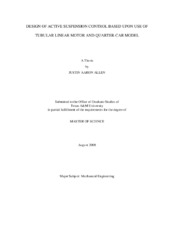| dc.description.abstract | The design, fabrication, and testing of a quarter-car facility coupled with various
control algorithms are presented in this thesis. An experimental linear tubular motor,
capable of producing a 52-N force, provides control actuation to the model. Controllers
consisting of two designs were implemented: a classical controller employing lead and
lag networks and a state-space feedback design. Each design was extensively simulated
to screen for receptiveness to actuation force limitations and robustness regarding the
inexact tire modeling. The goal of each controller was to minimize the acceleration of
the sprung mass in the presence of simulated road disturbances, modeled by both
sinusoidal and step input excitation wheels.
Different reference velocity inputs were applied to the control scheme. Responses
to a zero reference were juxtaposed to those that resulted from tracking a reference built
off a model that incorporated inertial-frame damping attached to the sprung mass. The
outcome of this comparison was that low-frequency disturbances were attenuated better
when tracking a zero reference, but the reference relaxation introduced by the inertialframe
damping model allowed for better-attenuated high frequency signals. Employing
an inertial-frame damping value of 250 N-s/m, the rejected frequency component of the
system response synchronous with the disturbance input excitation of 40 rad/s bettered by
33% and 28% when feeding control force from the classical controller and state-space
controller, respectively.
The experimental analysis conducted on the classical and state-space controllers
produced sinusoidal disturbance rejection of at worst 50% within their respective
bandwidths. At 25 rad/s, the classical controller was able to remove 80% of the base component synchronous with the disturbance excitation frequency, while the state-space
controller filtered out nearly 60%.
Analysis on the system's ability to reject step disturbances was greatly
confounded with the destructive lateral loading transferred during the excitation process.
As a result, subjection to excitation could only occur up to 25 rad/s. At the 20 rad/s
response synchronous to the disturbance excitation, the classical and state-space
controllers removed 85% and 70% of the disturbance, respectively. Sharp spikes in timebased
amplitude were present due to the binding that ensued during testing. | en |


